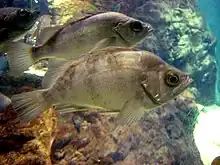| Sebastes cheni | |
|---|---|
 | |
| Scientific classification | |
| Domain: | Eukaryota |
| Kingdom: | Animalia |
| Phylum: | Chordata |
| Class: | Actinopterygii |
| Order: | Scorpaeniformes |
| Family: | Scorpaenidae |
| Genus: | Sebastes |
| Species: | S. cheni |
| Binomial name | |
| Sebastes cheni Barsukov, 1988 | |
Sebastes cheni, the Japanese white seaperch or Japanese blueback seaperch, is a species of marine ray-finned fish belonging to the subfamily Sebastinae, the rockfishes, part of the family Scorpaenidae. It is found in the Northwest Pacific. The species is a popular quarry for anglers. White seaperch is fished for food and game fishing. In Japan this species is known as Mebaru(メバル/鮴).
Taxonomy
Sebastes cheni was first formally described in 1988 by the Soviet zoologist Vladimir Viktorovich Barsukov with the type locality given as Tsuruga in Fukui Prefecture in Japan.[1] This taxon has been regarded as a colour morph of S. inermis in the past and alongside S. ventricosus, these three taxa form a species complex.[2] Some authorities place this species complex in the subgenus Mebarus. The specific name honours Lo-Chai (“Lloyd”) Chen of San Diego State University who showed that this was a new species in 1985 in his study of the S. inermis species complex but did not give it a name.[3]
Description
Sebastes cheni has a body which is dark golden-brown on the back and sides when fresh. Its pelvic fin extending past the anus when lowered. The pectoral fins have 17 rays and the anal fin has 8 rays. The lateral line contains 37–46 pored scales.[2]
Distribution and habitat
Sebastes cheni is found in the northwestern Pacific Ocean. It occurs as far north as the Iwate and Akita Preferctures south to Kyushu in Japan and off the southern part of the Korean Peninsula.[2] This species is one of the dominant fish species in seagrass and seaweed beds.[4]
Biology
Sebastes cheni juveniles feed mainly on copepods.[4] The juveniles swim and feed in schools in the daytime but at night they form rather loose aggregations and they youngest suffer the highest predation. As they grow and develop their schooling behaviour becomes more effective and predation pressure reduces.[5]
References
- ↑ Eschmeyer, William N.; Fricke, Ron & van der Laan, Richard (eds.). "Species in the genus Sebastes". Catalog of Fishes. California Academy of Sciences. Retrieved 5 November 2021.
- 1 2 3 Yoshiaki Kai; Tetsuji Nakabo (2008). "Taxonomic review of the Sebastes inermis species complex (Scorpaeniformes: Scorpaenidae)". Ichthyological Research. 55 (3): 238–259. doi:10.1007/s10228-007-0029-7. S2CID 5923317.
- ↑ Christopher Scharpf & Kenneth J. Lazara, eds. (22 May 2021). "Order Perciformes (Part 8): Suborder Scorpaenoidei: Families Sebastidae, Setarchidae and Neosebastidae". The ETYFish Project Fish Name Etymology Database. Christopher Scharpf and Kenneth J. Lazara. Retrieved 4 November 2021.
- 1 2 Yasuhiro Kamimura; Akihide Kasai & Jun Shoji (2011). "Production and prey source of juvenile black rockfish Sebastes cheni in a seagrass and macroalgal bed in the Seto Inland Sea, Japan: estimation of the economic value of a nursery". Animal Ecology. 45 (3): 367–376. doi:10.1007/s10452-011-9360-1. S2CID 25220225.
- ↑ Jun Shoji; Hiromichi Mitamura; Kotaro Ichikawa; Hikari Kinoshita & Nobuaki Arai (2017). "Increase in predation risk and trophic level induced by nocturnal visits of piscivorous fishes in a temperate seagrass bed". Scientific Reports. 7 (1): 3895. Bibcode:2017NatSR...7.3895S. doi:10.1038/s41598-017-04217-3. PMC 5478620. PMID 28634330. S2CID 24963844.
External links
 Data related to Sebastes cheni at Wikispecies
Data related to Sebastes cheni at Wikispecies
